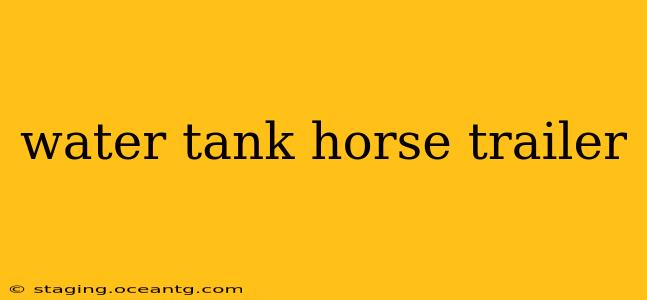Transporting horses requires meticulous planning and the right equipment. While a standard horse trailer gets you from point A to point B, many equestrians find that adding a water tank significantly enhances their travel experience, benefiting both the horses and the handler. This comprehensive guide explores everything you need to know about water tank horse trailers, addressing common questions and concerns.
What are the Benefits of a Water Tank in a Horse Trailer?
A water tank in your horse trailer offers several key advantages:
-
Hydration on the Go: The most obvious benefit is ensuring your horses stay properly hydrated during long journeys. Dehydration can lead to stress, colic, and other health problems, especially during hot weather or strenuous travel. Having fresh water readily available minimizes these risks.
-
Reduced Stress: Access to water reduces stress levels in horses, making them calmer and more comfortable throughout the trip. This is especially important for younger horses or those prone to anxiety.
-
Emergency Preparedness: A water tank provides a crucial emergency water supply in case of unexpected delays or breakdowns. This safeguard can be vital in preventing dehydration in critical situations.
-
Convenience: Eliminates the need for frequent stops to refill water buckets, saving you time and effort on long hauls.
How Much Water Capacity Do I Need?
The ideal water tank capacity depends on several factors:
- Number of Horses: More horses require a larger water tank.
- Trip Length: Longer trips necessitate a greater water volume.
- Weather Conditions: Hot weather increases water consumption, demanding a larger tank.
- Individual Horse Needs: Some horses drink more than others, so individual needs should be considered.
It's wise to overestimate your water needs rather than underestimate them. A larger tank ensures you're adequately prepared for unexpected situations.
What Types of Water Tanks are Available for Horse Trailers?
Several types of water tanks are compatible with horse trailers:
-
Built-in Tanks: These are integrated directly into the trailer's structure during manufacturing, providing a sleek and integrated solution.
-
Aftermarket Tanks: These are added to existing trailers and offer flexibility in terms of size and placement. Installation might require professional assistance.
-
Portable Tanks: These are separate tanks that can be easily moved in and out of the trailer as needed. They provide portability but might not be as integrated as built-in options.
How Do I Maintain a Water Tank in My Horse Trailer?
Proper maintenance is crucial to ensure your water tank remains clean and functional:
-
Regular Cleaning: Clean the tank regularly with a food-safe cleaner and rinse thoroughly to prevent bacterial growth and maintain water quality.
-
Winterization: In colder climates, winterize the tank to prevent freezing and damage.
-
Leak Checks: Regularly inspect for leaks to prevent water loss and potential damage to the trailer.
What are the Safety Considerations for Water Tanks in Horse Trailers?
-
Secure Mounting: Ensure the tank is securely mounted to prevent shifting or damage during transit.
-
Proper Drainage: A drainage system is crucial to prevent water buildup and potential damage.
-
Weight Distribution: Consider the added weight of the water tank and its impact on the trailer's weight distribution and towing capacity.
Where Can I Buy a Water Tank Horse Trailer?
Water tank horse trailers can be purchased from various sources, including:
-
Horse Trailer Dealers: Many dealers offer trailers with integrated water tanks or can install aftermarket options.
-
Custom Trailer Builders: Custom builders can create trailers tailored to your specific needs and preferences, including water tank capacity and placement.
-
Online Retailers: Several online retailers sell water tanks and related accessories.
This guide provides a comprehensive overview of water tank horse trailers. Remember to carefully consider your specific needs and consult with professionals to ensure you choose the right system for your equine transport requirements. Safe travels!
